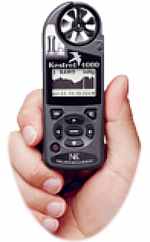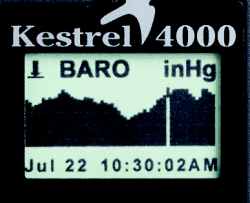
Two years ago, I reviewed the Kestrel® 3000 pocket weather meters manufactured by Nielsen-Kellerman. In the original review for that instrument (since updated), I stated that all that was missing from that instrument was a barometer function, and looked forward to the Kestrel® 4000. Well, I am happy to report that Nielsen-Kellerman has now released this instrument.
 |
| Kestrel 4000 Pocket Weather Tracker Photo Courtesy of Nielsen-Kellerman |
The Kestrel® 4000 packs four important weather sensors -- measuring wind speed, temperature, humidity and atmospheric pressure (or altitude)-- into its compact, light case. It weighs but 102 grams [3.6 ounces] and measures 12.7 x 4.5 x 2.8 cm [5 x 1.8 x 1.1 in], about the size of a cell phone.
The rugged unit is waterproof and floats. In contrast with other Kestrel® units, the 4000 has a hard protective cover only over the anemometer. This allows the exposure of other sensors while protecting the anemometer's impeller from damage. The unit runs on two AAA alkaline batteries with a typical life of 400 hours. When I reviewed the Kestrel® 3000, I wrote: The other small drawback to the unit is that an external light source is needed to read the display under very low light conditions..." In the Kestrel® 4000, the data display screen is backlit by a good light that allows it to be viewed under dark conditions.
But, almost as impressive as its measuring abilities, are its various functions which allow you to store and display measurements and provides a variety of alternate weather parameters/indices. For example, the ambient humidity is expressed as relative humidity, dew point and wet-bulb temperature. Combinations of measurements give heat index and windchill values. Although the manual does not give the formulae for how the calculation of these indices is made, it does state that the windchill is based on the new 2001 windchill equation adopted by both the US and Canada.
With a simple press of a button, you can cycle through the various read-outs available on the Kestrel® 4000:
| air temperature | wind chill temperature | heat index temperature |
| relative humidity | wet-bulb temperature | dew point temperature |
| wind speed | barometric pressure | time and date functions |
| altitude | density altitude |
In addition, there is a choice of units for temperature/humidity functions in degrees Celsius or Fahrenheit; and wind speed in knots, kilometres per hour, miles per hour, metres per second, feet per minute or the Beaufort wind scale, pressure in inches mercury, millibars, hectopascals and pounds per square inch, and altitude in feet or metres.
I compared measurements using the Kestrel® 4000 with my Kestrel® 3000 unit and found close agreement, except for windchill which uses a different formula. The altitude meter required a small field trip and when set to sea-level, on the beach at low tide and then reread at a couple of known elevation locations, the agreement was within a metre or two of what I expected.
The variety of applications for this very versatile instrument is almost endless. The weather buff will find many applications including micrometeorology surveys. Sports enthusiasts, particularly those involved in sailing, skiing, running and golfing, and those interested in outdoor activities from gardening to hiking to fishing to rock climbing will find many uses for the instrument. In addition, professional and amateur scientists can use the Kestrel® 4000 to take measurements from biological and environmental surveys to HVAC applications. [For full specifications, go to the manufacturer's website.
 |
| Kestrel 4000 Display Screen Photo Courtesy of Nielsen-Kellerman |
When in automatic data capture mode, the instrument will "wake up" each interval to take its measurements, even if the unit has been shut down. To take a spot reading, the camera button on the instrument is pressed (for manual entry, the instrument must be turned on). During automatic capture mode, individual readings may also be added to the record by pressing the camera button.
The automatic data storage rate can be set to any one of several common settings, or the instrument can be set to manual-entry mode. The storage buffer for each parameter is 250 datum points. Thus, the full data record length that can be stored depends on the sampling rate chosen. Sampling twice a day allows storage of almost 18 weeks of data, hourly sampling gives about a week and a half, and a one-minute rate results in a maximum 4 hour, 10 minute sample.
While data are in storage, individual readings can be recalled by going to the chart mode and moving a cursor along the data curve. At each point, the date/time and value are given. An optional, PC interface connector can be purchased to download data directly to a computer.
The only major drawback I found with the Kestrel® 4000, was in the Max-Avg-Min screens for each parameter. These statistics are determined from the complete data set (of as many as 250 datum points), but often I am interested in, say the high and low temperatures over the last 24 hours or calendar day. To determine this information, I would have had to remember to clear the memory each day or worked my way through the hourly readings to find the highest and lowest. A choice of averaging times would have been very useful so that one could cycle through a number of common averaging periods: last hour, last 12 hours, last 24 hours, previous day, or previous week.
In addition, the small screen display minimizes most small changes in the data if you set it to a normal range for the parameter, say 990 to 1040 mb for pressure. You can, however, set the graph range manually to better fit the range for a more appropriate resolution to view the variations. A "quick button" to set the graph range to the data range would, however, also have been a good addition.
While I am suggesting added features to the instrument (I know the manufacturer has listened to at least one of my previous suggestions), I would add a screen with the pressure tendency over the last hour or 3-hour interval or perhaps a selection of tendency intervals, because pressure tendency is more important to know than absolute pressure for most weather applications. This would be very useful to those engaged in outdoor activities as an indication that stormier weather may be approaching or that clearing may be expected.
I find the Kestrel® 4000 a very useful instrument with a wide range of applications sure to fit the needs of almost everyone interested in the weather or its impacts on activities. I regret that such a sensor was not available during my research and applications career; there were many times I could have used one. (Thirty years ago while a graduate student, I did conceive of such an instrument that could be useful in agricultural or biometeorology studies, but never did I dream one could be this compact.)
If time history of weather data on the small scale are important to you, then I recommend taking a long and hard look at the Kestrel® 4000. It is the best overall, compact weather sensor that I have seen, particularly with its large data storage capability. Its wide versatility makes the Kestrel® 4000 a welcome addition to any outdoors gear or sports bag. If you are looking for that special and unique gift idea for someone who loves the weather or the outdoors in any of a myriad of ways, then I highly recommend you consider purchasing the Kestrel® 4000.
For those who may not need all the functions of this instrument, take note. The Kestrel® 4000 is but one of the Kestrel® series of weather meters manufactured by Nielsen-Kellerman. Those with less money to spend or not wanting all sensors can purchase the Kestrel® 3000 (wind speed, humidity and temperature sensors) the Kestrel® 2000 (wind speed and temperature sensors) or the Kestrel® 1000 (wind speed only). These are similarly designed units but with fewer sensors included in the unit and therefore have lower prices.
Keith C. Heidorn, PhD
THE WEATHER DOCTOR
April 25, 2002